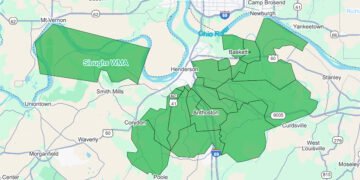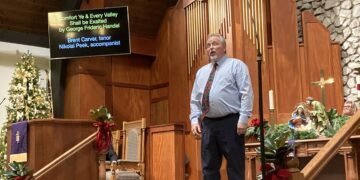City of Henderson officials have released a plan they hope will fix salary issues in the fire and police departments.
The plan, in effect, attempts to correct an issue that fire department employees have come to call “skipping” as well as raise pay rates across the board for all fire and police department employees below the chief and deputy chief levels, said City Manager Dylan Ward.
Currently, the city’s payroll is divided into two different pay plans—a hazardous pay plan, which includes the fire and police departments, and non-hazardous, which includes every other city employee.
Ward, Finance Director Chelsea Mills and Human Resources Director Megan McElfresh are proposing to move the hazardous pay plan employees onto the non-hazardous pay plan and then only have one pay plan.
To do that, though—and do it fairly—has been easier said than done, according to Ward. City officials have been working on getting this done for about a year, he said.
The difficulty of that task has been pinpointing the “skipping” issue and then creating an equitable conversion for fire and police employees moving from the hazardous plan to the non-hazardous plan.
According to those working on the pay plans, the skipping issue is attributed to the convoluted promotion schedule associated with the hazardous pay plan. City officials say the hazardous pay plan was adopted in 2016, and at the time, it was put in place to provide more equitable pay for the nature of the work.
After several years, though, employees in the fire department noticed an unfair glitch. Ward said there’s a specific instance involving three firefighters all hired at the same time. Two of those firefighters promoted earlier than the third, he said. Later, when the third promoted, that employee earned more than the two that promoted earlier, thus the description of “skipping.”
Ward said this related directly with the convoluted promotion steps in the hazardous pay plan.
The city manager said that city administrators have asked both the fire and police department officials to look for any more instances of “skipping” in their payrolls.
In the meantime, Ward, Mills and McElfresh introduced the plan to the Henderson City Commission in a March 18 work session. It will be revisited in April meetings when city staff will seek approval from the city commission, Ward said. If it is approved, it can be implemented May 1, Ward said.
Once the hazardous pay plan is merged with the non-hazardous pay plan, it will become part of all-employee city plan in which each step up the promotion ladder is logical and “algebraic,” and with a set percentage for each upward move, Ward said.
What will current employees make once converted to the non-hazardous plan?
Ward detailed the conversion that officials have been working on. He also verified the figures that are shown in the example below are accurate.
To determine salaries moving from the hazardous plan to the proposed pay plan, the first step is to determine the pay grade of each employee below chief or deputy chief.
The next step is to determine the percentage that employee’s salary is above the current minimum of the pay grade they are in.
For example, the current minimum for an employee in Firefighter Pay Grade 22 is $46,481.50. An employee in that pay grade should determine their current salary’s percentage more than the current minimum. If an employee in this grade is making $48,500, the percentage above the current minimum is 4.342%.
The next step is to take the percentage above the current minimum and then apply it to the proposed minimum. The proposed minimum for Firefighter Pay Grade 22 is $50,763.15.
So, multiply 4.342% by the proposed minimum and then add that number to the proposed minimum to get the new salary in the transition for this employee.
In this case, the proposed minimum ($50,763.15) plus the percentage above the proposed minimum ($2,204.44) equals the new salary for the employee ($52,967.59).
Calculating for the new salary in the transition, though, is just the first step, Ward said.
The next step is to add a 2.5% merit bonus. City officials said that this bonus will be added to all fire and police employees when the conversion is implemented. Normally, Ward said that city employees get the chance to obtain a merit bonus after six months on the city payroll.
He said city staff decided to implement this bonus to all employees involved in the transition at the time it’s implemented because there was a chance that new employees hired under the new plan could “skip” other recent hires who came in under the old plan.
For the example above, the 2.5% of the proposed minimum ($50,763.15) is $1,269.08. Add that on to the salary and it brings the new pay up to $54,236.67.
In the example, the firefighter that had been making $48,500 will get a $5,736 bump starting May 1, if the commission approves the plan.
Another bump for all city employees will occur on July 1, when the city’s annual cost of living adjustment goes into effect, Ward said. He said that this year it’s most likely the city will adopt a 2% COLA.
Mills said this conversion along with the benefits tied to it will cost the city $800,000. Ward said the city earmarked $650,000 as a placeholder during the budget process last year, and so that amount is ready for use to pay for the costs during this fiscal year. If the plan goes into effect May 1, Mills said it would cost the city $140,000 in this year’s budget.
The city would then need to determine how best to pay for the remaining costs of the plan in next year’s budget.




















